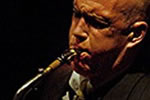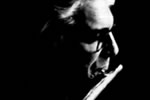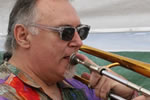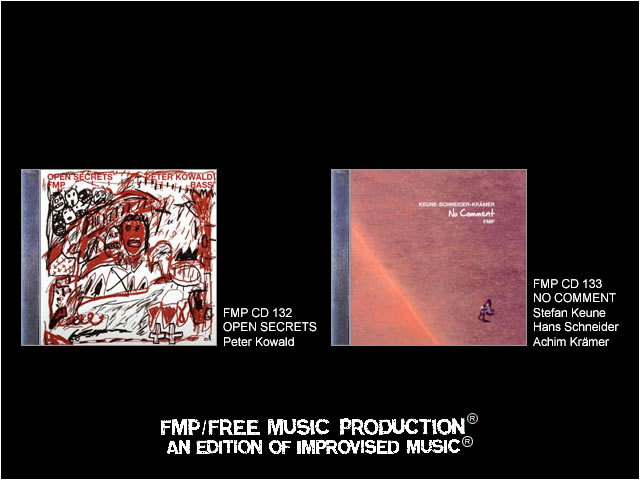What's New?
The PoD Roundtable
moderated by Bill Shoemaker
What’s New? is an email roundtable that draws together persons of diverse backgrounds to discuss the issues shaping jazz and constituent experimental musics in the early 21st Century.
The panelists for this roundtable include:
 Coat Cooke, a Vancouver-based composer, saxophonist and organizer. As the founder and leader of NOW Orchestra, Cooke has toured Canada, the USA and Europe performing in major festivals in Berlin, Lisbon and Chicago. He also administers the NOW CD label, whose first five releases are discussed in this issue’s Ezz-thetics column by Stuart Broomer. As a composer, Cooke has written for dance, film, and spoken word, and for configurations from solo piano to large ensembles. His collaborations include work with George Lewis, Wadada Leo Smith, Roscoe Mitchell, Butch Morris, and most recently with Marilyn Crispell. He also leads the Coat Cooke Trio and Meta 5, and co-leads Direct Current with bassist David Chokroun. More information about Coat Cooke can be accessed at: www.coatcooke.com.
Coat Cooke, a Vancouver-based composer, saxophonist and organizer. As the founder and leader of NOW Orchestra, Cooke has toured Canada, the USA and Europe performing in major festivals in Berlin, Lisbon and Chicago. He also administers the NOW CD label, whose first five releases are discussed in this issue’s Ezz-thetics column by Stuart Broomer. As a composer, Cooke has written for dance, film, and spoken word, and for configurations from solo piano to large ensembles. His collaborations include work with George Lewis, Wadada Leo Smith, Roscoe Mitchell, Butch Morris, and most recently with Marilyn Crispell. He also leads the Coat Cooke Trio and Meta 5, and co-leads Direct Current with bassist David Chokroun. More information about Coat Cooke can be accessed at: www.coatcooke.com.
 Vinny Golia, a Los Angeles-based composer, multi-instrumentalist and bandleader. Golia has led ensembles ranging in size from duos to his 37-piece Large Ensemble throughout Europe, Japan and North America. He has won numerous awards as a composer, including grants from the National Endowment of the Arts, The Lila Wallace Commissioning Program, The California Arts Council, Meet the Composer, Clausen Foundation of the Arts, Funds for U.S. Artists and the American Composers Forum. Golia founded Nine Winds in 1977; the label now has over 120 recordings by West Coast artists, including the bulk of Golia’s extensive discography. A former Regent's Lecturer at the University of California at San Diego, Golia is currently on the faculty of the California Institute of the Arts. For more information, visit: www.ninewinds.com.
Vinny Golia, a Los Angeles-based composer, multi-instrumentalist and bandleader. Golia has led ensembles ranging in size from duos to his 37-piece Large Ensemble throughout Europe, Japan and North America. He has won numerous awards as a composer, including grants from the National Endowment of the Arts, The Lila Wallace Commissioning Program, The California Arts Council, Meet the Composer, Clausen Foundation of the Arts, Funds for U.S. Artists and the American Composers Forum. Golia founded Nine Winds in 1977; the label now has over 120 recordings by West Coast artists, including the bulk of Golia’s extensive discography. A former Regent's Lecturer at the University of California at San Diego, Golia is currently on the faculty of the California Institute of the Arts. For more information, visit: www.ninewinds.com.
 Michael Vlatkovich, a Los Angeles-based trombonist, composer, and arranger. A St. Louis native, Vlatkovich was a scholarship student at the St. Louis Institute of Music; his fellow students included Hamiett Bluett, Julius Hemphill, and Oliver Lake. In addition to leading his own diverse ensembles, Vlatkovich has performed with a wide array of artists, spanning singers like Peggy Lee and Bryan Adams and jazz artists including Bobby Bradford, Rob Blakeslee, and Rich Halley. The trombonist has also performed on sound tracks for a variety of television and film projects including the acclaimed John Cassavettes' film The Tempest. In 1981, Vlatkovich formed Thankyou Records in order to document his music, as well as that of his collaborators. In addition to leading his own ensembles, and co-leading Transvalue with poet Charles Britt, Vlatkovich is also a regular member with the Vinny Golia Large Ensemble and Rob Blakeslee Quartet. More information can be found at: michaelvlatkovich.wordpress.com.
Michael Vlatkovich, a Los Angeles-based trombonist, composer, and arranger. A St. Louis native, Vlatkovich was a scholarship student at the St. Louis Institute of Music; his fellow students included Hamiett Bluett, Julius Hemphill, and Oliver Lake. In addition to leading his own diverse ensembles, Vlatkovich has performed with a wide array of artists, spanning singers like Peggy Lee and Bryan Adams and jazz artists including Bobby Bradford, Rob Blakeslee, and Rich Halley. The trombonist has also performed on sound tracks for a variety of television and film projects including the acclaimed John Cassavettes' film The Tempest. In 1981, Vlatkovich formed Thankyou Records in order to document his music, as well as that of his collaborators. In addition to leading his own ensembles, and co-leading Transvalue with poet Charles Britt, Vlatkovich is also a regular member with the Vinny Golia Large Ensemble and Rob Blakeslee Quartet. More information can be found at: michaelvlatkovich.wordpress.com.
****
Bill Shoemaker: Creative musicians up and down the West Coast of North America have been as determinedly DIY as any on the planet. Each of you has spent years learning the necessary skills to perform and record your music. Generally, you have faced the same hurdles as other musicians throughout the world; but, there are undoubtedly there are issues you have confronted that are region or city specific. Which of them have been most salient in your work as musicians and builders of communities?
Vinny Golia: Ok, well first thank you for calling us “artists and builders of communities.” To answer your question I think that here in Los Angeles we face an intense lack of interest in our music and encounter constant ridicule from a fair amount of older musicians who dismiss us as having no knowledge of the history of music or say we are unable to play our instruments, even that compositionally we are involved in formless exercises, (here I will also say there are a number of older musicians who do support the music or have an interest in what it is we do, but the majority do not). The press here is non-existent at the moment and there’s a lack of venues that will invite us to play let alone pay us to appear. The recording industry is in flux so any labels based here in L.A. are cool and distant to any of our needs. Lastly, a large number of recording studios which could house larger ensembles have closed, making the price of recording large ensembles playing live out of financial reach to most normal musicians/bandleaders and the existing labels want us to conform to their standards of complacency. On top of all this is the fact that our city is geographically spread out and there’s no reliable public transportation, which prevents a solid fan base. These are some of the problems with our home city, Los Angeles.
So to answer these questions, a number of us have now played or composed in so many settings here in LA, from movie scores to contemporary composition, that we are now considered “real” musicians or composers as we have performed often as invited guests by other established composers, and other ensemble leaders of more traditional musics. In terms of recording we start our own labels and attach the more open-minded interests we have to the label profile. We create music in venues we discover, create or infiltrate as players of other forms of music. As for the press, we make our presence known throughout the world by our recordings, our performances globally, and appearances in other press outlets through the Internet and international press. We make people here feel that we are part of a very burgeoning music scene, which is multi-directional. The valiant few that act as presenters look for venues that will support specific geographic areas like the west side, i.e.; Venice, Santa Monica, or Pasadena and Orange County and try to present on days when the other presenters are dark. Lastly, we nurture new upcoming musicians and artists interested in what we do as the elders before us nurture us. Oh, yes we also play out of town as much as possible.
Michael Vlatkovich: This question has been really difficult for me to answer. I don't know what to write. It is hard to perform the type of music I choose to do. What I mean by that statement, is that it is technically difficult. It demands a certain competency and it also can be difficult to find a venue interested. The ironic thing is that my music isn't very strange. There is a strong prejudice against this music by educators and musicians. I don't know that it would have been any different in another large metropolitan area. You need to figure out what it is that you wish to do and then find like-minded people. In some areas of the world, there wouldn't be many, possibly none. One needs to find some sort of support and encouragement in the beginning. You also need to learn how to be creative and express your vision.
In Los Angeles, there are a number of like-minded individuals. I slowly over time found them and they found me. It is a diverse community with varying degrees of support in terms of available venue/series and audiences. Do the musicians support the series as audience members? I would have to say no. Do the press/writers support the musicians and venues? That answer would be no as well. There is a small audience, but they can't come to everything. There are a few supportive writers and like the audience they can't write about everything either. I do my music because that's what I do. In a bigger city like Los Angeles, what I do can be done. That's why I'm here.
Even though the communities' style/sound may be different, we all do wish to cultivate an audience and often work together towards that goal. Some cities may be better at it than others?
Coat Cooke: First of all, it seems to me that we have a lot more in common that not. We all have difficulty with adequate financial resources, building audiences, dissemination of the music, cultivating venues and so on.
That being said, I would say the primary determining factor in Vancouver's creative music scene over the last thirty odd years has been our geographical isolation. Without access to other populated centers in close proximity, players on Canada's west coast have tended to be comparatively insulated musically.
We have found difficulties in accessing the west coast American cities because of restrictive work permit/immigration policies and limited access to other significant population centers in Canada because of geographical distance and the costs related to this. This has worked for us and against us, and this has spurred us to work closely as a small, resourceful and motivated group.
For our growth, besides recordings, we have collaborated with artists from around the world. This dates back to my first experiences in Vancouver that included artists like Karl Hans Berger, Günter Christmann, Roscoe Mitchell and fellow panelist Vinny Golia, and continues to this day with collaborations with Nicole Mitchell, John Oswald and Amina Claudine Myers. Having the opportunity to share the music with great artists like this has been critical for our collective development in the oral tradition that we have in improvised music.
This kind of intermittent but regular exposure has been part of the recipe that has stimulated our scene to develop a Canadian west coast musical identity that is unique. This has come from our scene's players working extensively together in all sorts of combinations in various projects over a long period of time. I think that because of the individuals in our neck of the woods, we have developed our own take on these streams. We've been influenced in the way many centers have been by American improvised music tradition, world musics (this seems to be kind of a dated term now), European improvisation tradition, contemporary music, electronics, various technologies etc.
Shoemaker: There are vibrant traditions of dance, poetry, film and video, painting and sculpture with West Coast identities. Perhaps it is a function of distance, but back East, you rarely hear about inter-disciplinary collaborations between musicians like yourselves and artists working in other areas. How have this type of collaborations shaped your aesthetic?
Golia: That’s very funny as I teach a class at California Institute of the Arts with dancer/choreographer Kathy Carbone about this very subject. I think you do hear about these collaborations but only in the world of the collaborative art form. For example when I composed/performed the music for King Lear and Macbeth the theatre world and its critics were extremely happy to converse about the process of collaboration, but within the music writing community there was a dead silence, or the old stand-by, “well that’s not Jazz” or “that’s not classical music” so our music communities heard nothing about these collaborations. The same scenario goes for the work I have done with dancers and writers/poets, the film and other theatre work etcetera.
I want to digress for one minute and confront this part about “back east”. Art has no geographical boundaries let alone the man made boundaries of topography. The reason you do not hear about anything we do back east is that people who write about our chosen art forms decide to ignore us. If this were not the case Coat Cooke’s work with the Edam Dance company or the others he has worked with in Vancouver would be held as models for collaboration, or my work with director Travis Preston and the Center for New Media would be everyday knowledge. I ‘m sorry but I find this "east coast west coast" thing rather boring especially since most of the people out here on the west coast doing this music are from somewhere else, and most of the people on the east coast are from out here. I read a lot and in books about our music I do not see the names of John Carter, Bobby Bradford, Claude Ranger, Horace Tapscott, Rich Halley, Rob Blakeslee, etc., let alone my own name or any of the other panelists. What about Joey Sellars, Michael Sessions, Linda Hill, Roberto Miranda, Steve Adams, Larry Ochs? Does everyone really think nothing is happening on a well-populated area of land over three thousand miles long? Can all these people be so east coast centric? We are playing all the time and in many cases stronger (creatively, intensity, concentration) than musicians from many other well publicized areas in the US. We deserve to have some respect and attention. People may find out about us when we leave the planet but I am not going out without a fight. I think our music is wonderful and our collaborations very strong.
One other aspect of this has been the advent of the laptop, making electro acoustic music and performance art a very viable way to incorporate other mediums into our music, although it isolates the musician from the audience and the writers. As for informing our aesthetic, anytime you can transfer your ideas from one media to another it gives you the chance to see yourself and what you do through different eyes. The viewpoint becomes a new vista opening up wellsprings of creative juices and endless possibilities. You also became more aware of the flow of arts in time and motion. It’s as if you see in another dimension or you really add a dimension of time and space to the concepts being worked on.
There was a time in the arts when we were all very connected but for our generation of artists there’s a disconnect; however I strongly think that will change soon.
So calming down about the press or rather non press coverage of our inter-disciplinary work, I will concentrate on the question; Dance, Writing, and Visual art in regards to inter-disciplinary collaborations. As I said before this is an area which caused me to leave working only in visual arts in the 70's i.e.; painting, drawing, laser beams etc, and start to incorporate music and sound as my primary artistic focus.
Working with Dance opens up fantastic vistas for transmuting sound into movement. I think my past training as a visual artist really helps in this arena as I can react to movement very quickly and my interest in improvisation makes my responses almost instantaneous. I am also adding in this medium by the training in visual arts which helps me to see line, movement and motion. So by using dance collaboration as an addition to the traditional music experience an artist can come out with a more quick thinking linear approach which can be applied to many other music improvisation settings. There are also coloristic and compositional approaches that help change the way a person composes which adds another dimension their pure sound experiences.
The approaches you take with live theatre are quite different, here you have to concentrate on not being in the way of the actors emotions and direction, so the musical emphasis is on dynamics and pushing the action gently and not as interactive as in the dance experience, this is perfect training for interactions with singers for example and is quite like playing classical music to me. It's an analogy I use a lot.
With poets and writers the attention and intent is to comment and interact but not overpower with sound, slightly a different way of playing than all the other mediums. Many like the=2 0interaction of sound with their presentations. Some people who use words have develop stylist approaches where they do not speak, in these areas one is more drawn to interaction with the visuals as opposed to sound, which brings us to the word of visual art, an immense field which currently has myriads of stylistic approaches, video interactions, overlays, light environments, action painters, interactive set design etc. Here you can reverse the traditional roles, and create aural soundscapes that the visuals can interact in or even reverse these roles in which sound becomes more prominent.
These approaches of other mediums create an expansion of technical abilities of course but also inform your conceptual space as the artist is dealing with rhythm, shape, form and color in much more interactive methods especially more than in the traditional roles of music. Again the collaborations of interdisciplinary work lead one to be much more open and inclusive to alternate forms of thinking and this always leads to an expansion of technique and form. Here again we have to confront the traditional ways of thinking about what we do and who we are as artists, not just musicians and composers, but true artists able to adapt to our surroundings.
Vlatkovich: Poetry is the collaboration which I most frequently participate. I've been collaborating since 1980 with Chuck Britt and since the '90's with Mark Weber and Dottie Grossman. All three are different and thought provoking. I approach each differently and my hope is that it comes out that way.
I would gladly collaborate with other disciplines if asked. I think the problem sometimes can be that the disciplines are isolated from one another and it takes some effort to search out possible collaborators. Maybe these comments will be seen by someone interested? I think we three are interested. Until and unless an individual really explores our work/history, it can't be known what we really do. We are all complex and diverse individuals, a superficial approach is inadequate.
Vinny really says it well. I will defer to him. I feel exactly the same way.
Cooke: Upon reflection, I would say that my involvement with inter-disciplinary collaborations has impacted my work and interest fairly significantly. On Canada’s west coast there is a long-standing tradition of musical collaboration with other media. One of the early and most outstanding examples that I became aware of from my first experiences here is the work of musician/visual artist/writer Al Neil. Al’s work and his kind of exploration has been in the air here long before I arrived and I am certain that I picked up on that and has been integral to stimulating the interest that I’ve felt in collaboration.
I’ve been involved with working with west coast spoken word artists going back to the 1970s with writers like Gerry Gilbert and Jamie Reed through Kedrick James, John Sobol, Alex Ferguson and Sherri-D Wilson. The work with writers has involved working with set text and improvising with it as well as creating composed musical structures (that usually involve improvisation as well). These explorations have also included full on improvised music and word performances, both live and recorded. These word/music adventures have always had their challenges to investigate. One of the prime directives to be aware of for the music to work effectively with words - neither can be subservient to the other. This is a delicate balance that takes a fair amount of negotiation either through discussion or rehearsal or performance process. It is easy for the music to dominate the words, and it is easy for the music in being deferential to the words, to losing their strength. I’ve found this an exciting and very valuable area of collaboration to explore, as it applies to any kind of collaboration.
There is a wealth of visual stimulation to be inspired by also, from the amazing drummer/painter Gregg Simpson, to the creative video mixer Krista Lomax, to performing live soundtrack for film with Stefan Smulovitz’ Eye of Newt ensemble. With all of these artists I get pushed to find different ways to have the necessary musical conversations to communicate in these relationships that I feel compelled to seek out.
Perhaps the most developed of these collaborations has been with dancers.
All of this kind of inter-disciplinary work has informed my creative life.
